The Samsung Galaxy S6 and S6 edge Review
by Joshua Ho on April 17, 2015 9:00 AM EST- Posted in
- Smartphones
- Samsung
- Mobile
- Galaxy S6
- Galaxy S6 Edge
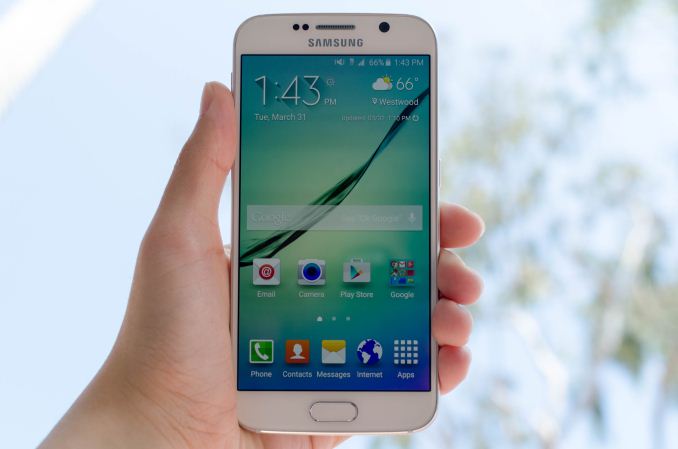
As recently as the Galaxy S5, Samsung had a fundamentally different strategy from companies like HTC and Apple. While design wasn’t ignored completely, Samsung Mobile had a different set of priorities. In general, it felt like Samsung wanted the phone to have every feature possible to please every possible potential customer. Features like a removable battery and microSD card slot seemed to be a crucial point of differentiation. TouchWiz focused on delivering a full suite of applications even if they were pretty much redundant when compared to Google’s applications. Samsung also seemed to cost-optimize their external shells, favoring polymer builds over glass or aluminum. Since the Galaxy S, this strategy paid off handsomely. With the help of strong marketing, Samsung proceeded to dominate the Android market from the days of the Galaxy S2, to the point that almost no other Android OEM was relevant in terms of market share.
However, Samsung’s tried and true strategy failed with the Galaxy S5. Fundamentally, Samsung had always been competing with Apple and their iPhone line-up at the high end, but Samsung consistently held a price advantage. The real problem was the rise of low-cost flagship phones, which squeezed Samsung significantly. Other OEMs were able to justify their high-end pricing by delivering a polished software experience and premium hardware design. In comparison to these relatively cheap phones which delivered largely the same experience and hardware, Samsung’s sales crumbled and the Galaxy S5 didn’t meet sales expectations.
This brings us to the Galaxy S6, which is supposed to be Samsung’s attempt at refocusing their product design and lineup. Design has become a major priority, and the Galaxy S6 is a radical departure from previous design in terms of almost every design choice. The Galaxy S6 represents the best that Samsung can make to some extent, as a great deal of the phone is composed of Samsung-made parts to achieve maximum vertical integration as seen in the specs below.
| Samsung Galaxy S5 | Samsung Galaxy S6 | Samsung Galaxy S6 Edge | |
| SoC | MSM8974ACv3 2.45 GHz Snapdragon 801 | Exynos 7420 2.1/1.5GHz A57/A53 | Exynos 7420 2.1/1.5GHz A57/A53 |
| RAM | 2GB LPDDR3 | 3GB LPDDR4-1552 | 3GB LPDDR4-1552 |
| NAND | 16/32GB NAND + microSD | 32/64/128GB NAND | 32/64/128GB NAND |
| Display | 5.1” 1080p SAMOLED HD |
5.1” 1440p SAMOLED |
5.1” 1440p SAMOLED, Dual Edge |
| Network | 2G / 3G / 4G LTE (Qualcomm MDM9x25 UE Category 4 LTE) | 2G / 3G / 4G LTE (Category 6 LTE) | 2G / 3G / 4G LTE (Category 6 LTE) |
| Dimensions | 142 x 72.5 x 8.1 mm, 145 grams | 143.4 x 70.5 x 6.8mm max, 138 grams | 142.1 x 70.1 x 7.0mm max, 132 grams |
| Camera | 16MP (5132 x 2988) Rear Facing with 1.12 µm pixels, 1/2.6" CMOS size, 31 mm (35mm effective), f/2.2 | 16MP (5132 x 2988) Rear Facing w/ OIS, f/1.9, object tracking AF | 16MP (5132 x 2988) Rear Facing w/ OIS, f/1.9, object tracking AF |
| 2MP Front Facing | 5MP Front Facing, f/1.9 | 5MP Front Facing, f/1.9 | |
| Battery | 2800 mAh (10.78 Whr) | 2550 mAh (9.81 Whr) | 2600 mAh (10.01 Whr) |
| OS | Android 4.4 w/TouchWiz |
Android 5 (64-bit) w/TouchWiz | Android 5 (64-bit) w/TouchWiz |
| Connectivity | 802.11a/b/g/n/ac 2x2 + BT 4.0 (BCM4354), USB3.0, GPS/GNSS, MHL, DLNA, NFC |
2x2 802.11a/b/g/n/ac + BT 4.1 (BCM4358), USB2.0, GPS/GNSS, NFC |
2x2 802.11a/b/g/n/ac + BT 4.1 (BCM4358), USB2.0, GPS/GNSS, NFC |
| Wireless Charging | N/A | WPC 1.1 (4.6W) & PMA 1.0 (4.2W) |
WPC 1.1 (4.6W) & PMA 1.0 (4.2W) |
| Fingerprint Sensor | Swipe | Touch | Touch |
| SIM Size | MicroSIM | NanoSIM |
NanoSIM |
Design
There’s a lot of ground to cover in the Galaxy S6 and S6 edge, but probably the most immediate change is to the design. The Galaxy S6 is a unibody design, with no apparent screws. This does mean that there’s no removable battery or microSD slot, which shouldn’t be a problem for most people although this may be enough for some to write off this phone completely.
The back cover is now glass instead of plastic, and is attached to the phone with glue instead of plastic latches. Regardless of color or model, Samsung has placed an extremely fine pattern beneath the glass that manages to be subtle but also surprisingly brilliant under direct light. It’s tasteful in a way that the Galaxy S5 and Note 4 weren’t. The back of the phone also has a single LED flash, a heart rate monitor, and the camera which bulges out significantly. I personally don’t have a problem with camera humps, but the Galaxy S6’s camera hump is probably the biggest I’ve seen in recent memory.
The glass back cover meets the metal frame of the phone, which provides most of the structural rigidity and strength. On the normal Galaxy S6, this frame has a very slight curve and is almost cylindrical along the top and bottom of the phone, but flattens out along the sides for better grip. The bottom of this frame has the speaker, microUSB port, and 3.5mm headphone jack, which does make for some resemblance with Apple products launched within the last year. At any rate, the placement of the speaker, USB port, and 3.5mm jack are all appropriate for a phone.
The left side of the frame contains the volume buttons, which are clicky and solid, although pressing the buttons off-center does produce a noticeable flex. The right side of the frame has the power button and the nanoSIM slot on the normal version.
On the edge variant, the sides of the frame are dramatically thinner and appear to be angled out when compared to the Galaxy S6. In the hand, this makes it feel much thinner than the S6, but it really feels almost too thin to hold comfortably. Combined with the flat back, it’s really a bit of a struggle to pick up the edge off of a table, which compromises usability when compared to the normal S6.
The top of the frame contains the IR LED for TV capabilities and a hole for a microphone. On the edge variant, the nanoSIM slot is relocated to the top of the phone.
The front of the phone is probably the only aspect of the design that feels relatively similar to the Galaxy S5. However, the texture of the bezel beneath the glass is similar to the subtle finish of the back cover, which makes for a unique visual effect that manages to be tasteful and quite unique. Other than this, we see the same layout as most Galaxy phones, with two capacitive buttons (multitasking on the left, back button on the right) and a physical home button. In the case of the Galaxy S6, this home button has been turned into a fingerprint scanner that is touch-based rather than a swipe sensor. Along the top of the front face, we also see the ambient light sensor, a proximity sensor, the earpiece, and the 5MP front-facing camera. Directly below these items is the display driver beneath the bezel, which is similar to the “logo bar” of the One M7, M8, and every other phone on the market today. On the S6 edge, the sides of the display are curved to reduce the width of the phone, which does make it easier to hold in the hand, but there’s really no bezel reduction here as the side bezels seem to be larger than what we see on the S6.
Overall, the design of the Galaxy S6 and S6 edge is really unlike anything else they’ve produced in recent memory. The phone itself is well-sized and feels much more ergonomic than the Galaxy S5 due to the thinner build and mildly reduced bezel size. It really feels like Samsung cared about the design of the phone this generation, and the attention to detail here immediately puts Samsung near the top in this area. The front of the phone still feels a bit derivative, but I suspect that there isn’t much Samsung can do to change this when faced with design constraints like a physical home button. The S6 edge does look better in some ways, but ergonomically the sharper and thinner edge is a compromise compared to the normal S6. Either phone is still easily one of the best-designed phones I’ve seen this year.


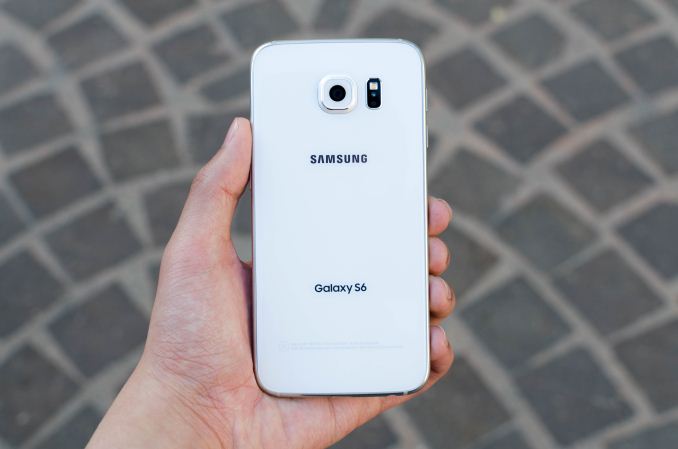
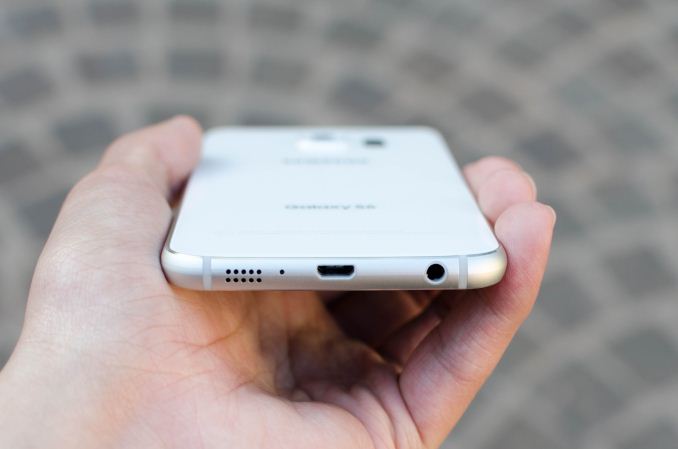
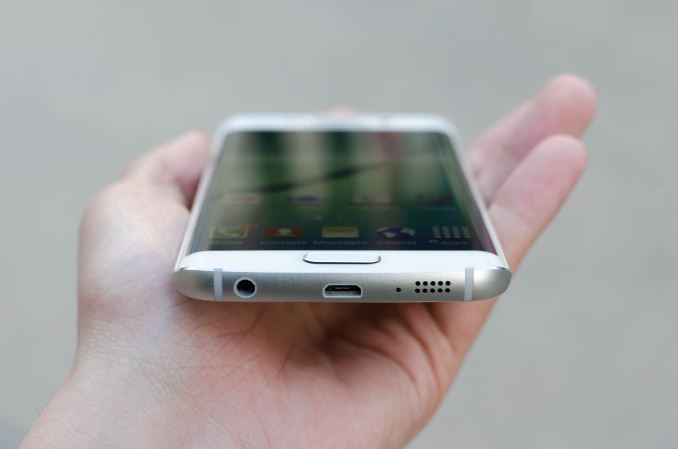



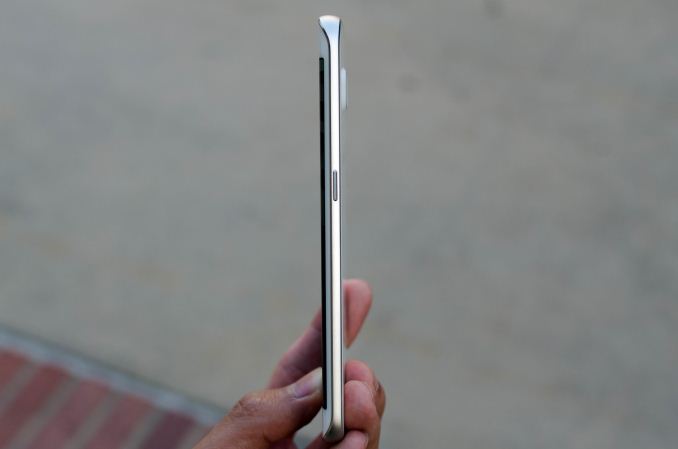

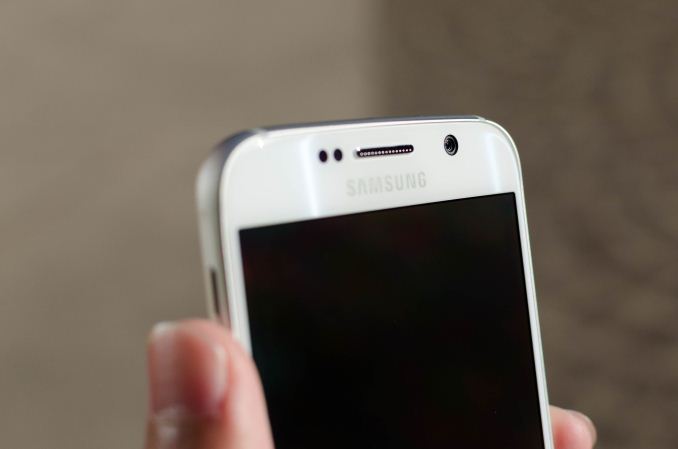
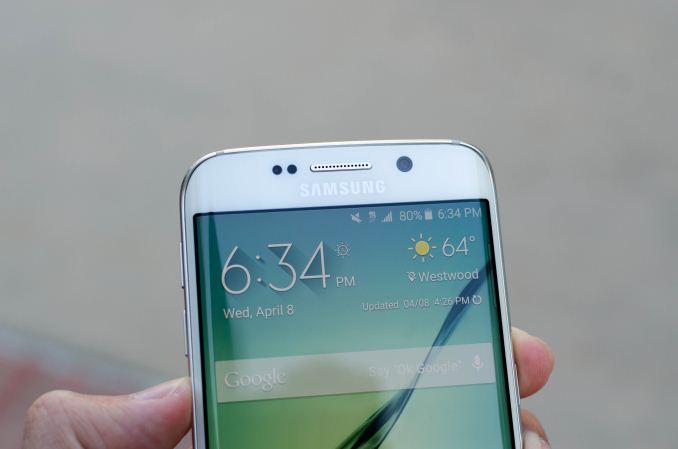








306 Comments
View All Comments
Drumsticks - Friday, April 17, 2015 - link
Thanks for the review! I've been waiting on the Anandtech review before looking at a new phone; y'alls simply can't be beat.The major concern for me with the S6 was battery life, but you seem to have put that concern to rest here. I fall under the "drawn by the new design" camp as well - I'm a pretty heavy user, but removable storage has never really mattered to me as I don't like keeping too much data on my phone. A removable battery is nice, but I'm already used to having a power pack with me so that's not a huge deal. I'm still waiting to see what the LG G4 brings though. If performance is good enough with the rumored SD 808 (really concerned about GPU driving the QuadHD Display), then the larger battery could make it worth it to go to LG. I'm also hoping that Samsung releases a custom theme tool, and somebody makes a relatively close stock Android icon/color set, as the default TouchWiz UI is kind of gaudy for me (teal? seriously?)
soccerballtux - Friday, April 17, 2015 - link
wow, I'm pretty impressed with the low-light performance of the camera.Novacius - Friday, April 17, 2015 - link
The first Android smartphone of recent dates that gets everything right imho. I'm considering buying it, but only when the price drops below 500 euros here.generalako - Friday, April 17, 2015 - link
I'm sorry, but I can't take Anandtech seriously anymore. I mean, just look at the the review of this phone's display. Somehow the iPhone 6 beats it in nearly every aspect, and there are key areas where the S6 is even worse than many other phones (like White Point). Compare this to DisplayMates shootout of the S6 (which is much more broad and of course has more legitimacy), who came to the conclusion that the S6 is the best phone display they have ever tested on almost every aspect. The same conclusion they had with the Note 4. Based on this review, however, the AMOLED on the S6 is still not better than the best LCD phone (iPhone 6).Let me give an example of how much these two tests vary, and how serious you should take Anandtech's test:
DisplayMate: "When Automatic Brightness is turned On, the Galaxy S6 reaches an impressive 784 cd/m2 (nits) "
Anandtech: Samsung Galaxy S6 reaches 610 nits.
That's a whole difference of 174 nits from the two tests!
Andrei Frumusanu - Friday, April 17, 2015 - link
DisplayMate derives that figure from a 1% APL pattern, which is pretty non-representative of any real-world use-case. The 610 nit figure here comes from a 100% APL image, meaning pure white. Also, if you read the bottom part of the display section, you will see the APL chart where we indeed show how brightness increases with lowering APL, reaching near the very figures that you are quoting.magreen - Friday, April 17, 2015 - link
You can't take Anandtech seriously because its data is (arguably) contradicted by one other review site's data?lesbaer45 - Friday, April 17, 2015 - link
As has been said repeatedly for a variety of reasons. No SD, not buying. No removable battery, not buying.I either hang on to the S5 until it dies or buy something else that meets my needs. Plain and simple.
Chaser - Friday, April 17, 2015 - link
Everyone has different phone usage preferences. I have no need for a 64-128GB SD card on top of the native storage. I have modest music stored and although I take a lot of photos I use One Drive's "camera roll" feature that immediately uploads new shots to my cloud when a usable wifi connection is made and they land on my PC in seconds.This removable battery/SD card "must have" mantra is getting old. I have absolutely no interest in carrying around an extra battery. Hopefully as native storage becomes more affordable and batteries even more efficient it will fade away forever.
Shadowmaster625 - Friday, April 17, 2015 - link
Its a shame they had to add all those wasted pixels. This phone would have much bettery performance and battery life at 1080p. I really dont get this need to drive so many pixels. The market needs to start penalizing this stupidity.Novacius - Friday, April 17, 2015 - link
I clearly see a difference because of the pentile matrix. For every green subpixel there are one bigger red and one blue subpixel. So the "effective resolution" is 1/3rd lower, which places the S5 at 288 dpi and the S6 at 384ppi respectively. Where I can see some sort of individual pixels or pentile "grain" on the S5's display, thats nearly impossible with the S6.